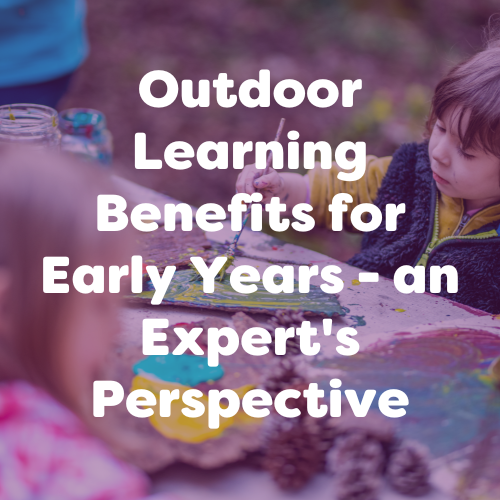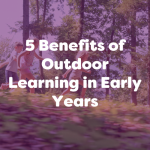
This article has been written by early years consultant, Anne Rodgers, from ATR Consultancy. Anne has 36 years’ experience of working in the childcare and education sector. This includes training practitioners, managing numerous settings and writing articles for Early Years Educator and the CACHE Alumni website. In this blog she discusses the benefits of outdoor education, the key messages and some outdoor learning ideas!.
Why is Outdoor Play important?
Children are naturally inquisitive and learn best when engaged in their environment. Outdoor learning is therefore an important part of the EYFS because it stimulates children’s curiosity, creativity, and imagination.
Children can take part in den building, obstacle courses, gardening, construction and countless other activities whilst also experiencing changes in the weather, seasons and nature. This ensures that children are constantly learning about the world around them and adapting themselves accordingly. In this blog we will delve into outdoor learning and the key factors to consider when introducing outdoor learning in your setting.
What are the benefits of Outdoor Learning?
- Physical development: it helps children to establish a healthy and active lifestyle and offers them the opportunities to use their bodies physically by engaging in various activities.
- Mental wellbeing: studies have found that time spent outdoors is linked to improved mood, confidence and general wellbeing
- Understanding of the world: being outside and amongst nature increases a child’s understanding of nature and the world around them in a hands on way
- Cognitive development: outdoor learning or play offers children the opportunity to explore new things, take risks and learn from their experiences
What are the key messages for Outdoor Learning?
The ‘EYFS Effective Practice: Outdoor Learning’ claims that the central messages for outdoor play learning are:
- The outdoor environment has unique characteristics and features
- Outdoor learning has equal value to indoor learning
- Outdoor learning has a positive impact on the children’s well-being and development
- Children need the support of attentive and engaged adults who are enthusiastic about the outdoors and understand the importance of outdoor learning
- Consider play materials that are versatile and adaptable.
- Children must be placed at the centre of provision being made
How can I incorporate Outdoor Learning?
Each childcare setting will have differing availability of outside spaces and therefore a lot needs to be considered…
- Firstly, an assessment of the outside area must be made to see how safe it is.
- Remember, children should be at the centre of the process of planning activities and experiences.
- When planning, practitioners need to consider their children’s needs and offer sufficient ways to meet these.
- Children should be allowed time to play and develop at their own pace and in their own way. Some activities may need to be adult-led and some child-led.
- Every child has the right to an environment which provides opportunities for risk taking, encourages independence and builds self-esteem.
- Finally, all children should be enabled to access the outdoor environment regardless of their ability.
It is important to remember that regardless of the outdoor space available to you, there are other options and ways to incorporate outdoor learning. Consider ways in which you can bring nature indoors. For example a nature investigation tray or indoor garden can be very easily maintained and managed. Exposing children to these natural elements indoor will proof beneficial and build children’s excitement and curiosity for the world around them.




